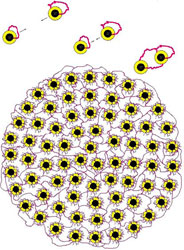| Posted: September 8, 2007 |
Ball lightning - a cloud of nanobatteries |
|
(Nanowerk News) Despite numerous attempts, an adequate theoretical and experimental simulation of ball lightning still remains incomplete. According to a model proposed by Oleg Meshcheryakov, general director of Wing Ltd. Company in Odessa, Ukraine, the processes of electrochemical oxidation within separate aerosol particles are the basis for this phenomenon, and ball lightning is a cloud of composite nano or submicron particles, where each particle is a spontaneously formed nanobattery which is short-circuited by the surface discharge because it is of such a small size.
|
|
As free discharge-shorted current loops, aerosol nanobatteries are exposed to a powerful mutual magnetic dipole–dipole attraction. The gaseous products and thermal energy produced by each nanobattery as a result of the intra-particle self-sustaining electrochemical reactions, cause a mutual repulsion of these particles over short distances and prevent their aggregation, while a collectivization of the current loops of separate particles, due to the electric arc overlapping between adjacent particles, weakens their mutual magnetic attraction over short distances.
|
 |
| Powerful interparticle magnetic attraction forms a stable cloud ball of short-circuited aerosol nanobatteries with total electric overlapping the surface discharges of separate particles (Image: Nanoscale Research Letters)
|
|
Discharge currents in the range of several amperes to several thousand amperes as well as the pre-explosive mega ampere currents, generated in the reduction–oxidation reactions and distributed between all the aerosol particles, explain both the magnetic attraction between the elements of the ball lightning substance and the impressive electromagnetic effects of ball lightning.
|
|
"It seems that the proposed model allows us to explain all the observable characteristics of ball lightning, in particular a smoke-like behavior, an ability to keep the form of a ball under conditions of strong atmospheric turbulence, as well as the electromagnetic effects of ball lightning" says Meshcheryakov.
|
|
This model also explains the great diversity of observable conditions and processes of ball lightning formation. In fact, any reduction-oxidation reaction inside the composite aerosol particles can be proceeded by an electrochemical mechanism under suitable conditions, and a lot of the intra-particle combinations of the three various substances, reductant-electrolyte-oxidizer, are capable of spontaneously forming short-circuited aerosol nanobatteries and the self-assembled ball clouds of these nanobatteries.
|
|
The concrete instructions to experimentally simulate the ball lightning phenomenon are strongly dependent on the chosen fuel-reductant and on the method of its atomization, and so they require separate discussion. In particular, not only the black carbon aerosols, but seemingly also the carbon aerogels, coated with a surface film of molten carbonate electrolytes and heated in an oxidizing atmosphere could be good primary experimental targets to make high-temperature electrochemical aerogel power sources short-circuited by plural surface arc discharges and slightly similar to the aerosol electrochemical generators—ball lightning—described above.
|
|
Meshcheryakov's article is available as a free download on the Nanoscale Research Letter website: "Ball Lightning–Aerosol Electrochemical Power Source or A Cloud of Batteries".
|

